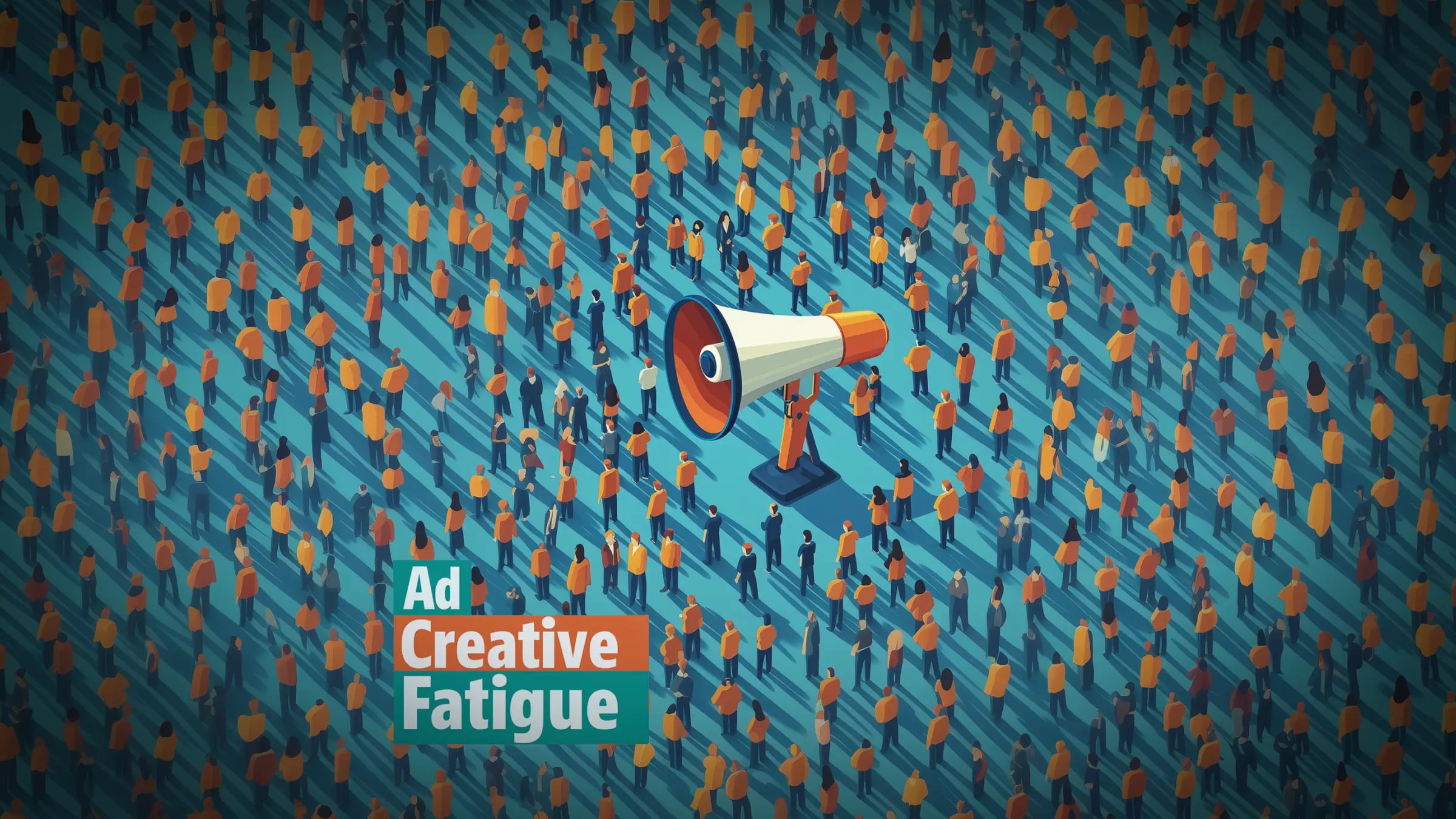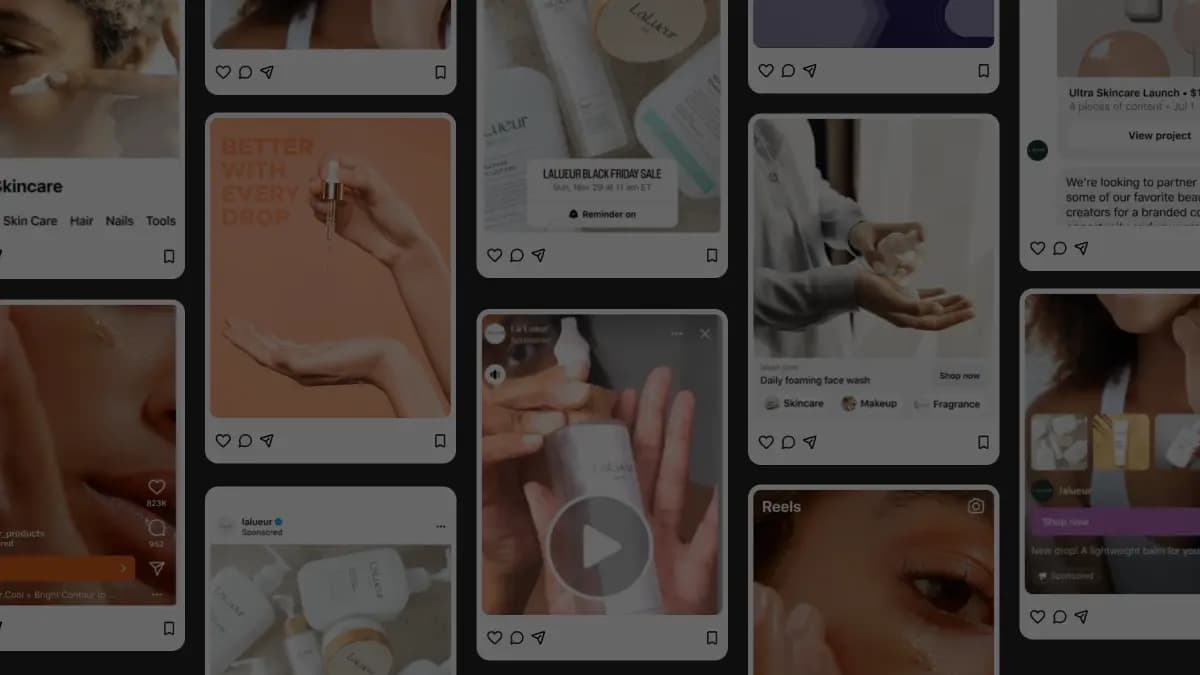Stay Updated
Get the latest insights on creative testing and ad optimization delivered to your inbox.
Get the latest insights on creative testing and ad optimization delivered to your inbox.

Master the art of identifying and managing creative fatigue in Meta advertising campaigns. Learn data-driven techniques, advanced analytics approaches, and proven strategies to maintain peak ad performance.
In the ever-evolving landscape of digital advertising, maintaining consistent ad performance is both an art and a science. At the heart of this challenge lies creative fatigue - a phenomenon that can silently erode campaign effectiveness and ROI. While this challenge exists across all digital platforms, Meta's advertising ecosystem presents unique considerations due to its sophisticated targeting capabilities and diverse ad formats[1].
Effectively managing ad performance is crucial for any digital marketing strategy. One of the key challenges advertisers face is creative fatigue, where the effectiveness of an ad diminishes over time due to repeated exposure. This phenomenon can occur across all digital platforms, including Meta (formerly Facebook), TikTok, and YouTube, but our focus here will be on Meta. Understanding how to identify and manage creative fatigue can significantly impact your campaign's success.
Creative fatigue occurs when ad performance declines due to audience overexposure, resulting in decreased engagement, lower CTRs, and reduced ROAS.
The impact of creative fatigue extends far beyond simple performance metrics - it represents a fundamental shift in how your target audience perceives and interacts with your advertising content. This comprehensive guide explores advanced techniques to detect, analyze, and combat creative fatigue in Meta advertising campaigns so you can avoid the pitfalls of creative fatigue and maximize your return on investment.
Creative fatigue manifests through a complex interplay of psychological and behavioral factors. When audiences repeatedly encounter the same creative elements, their initial interest and engagement naturally decline, leading to diminishing returns on ad spend[2].
Traditionally, marketers look for signs of creative fatigue through several key performance indicators (KPIs). The impact can be substantial across multiple metrics:
Average decline in click-through rate
Reduction in overall engagement
Decrease in return on ad spend
These metrics tell only part of the story. The real challenge lies in understanding the underlying patterns and psychological triggers that contribute to creative fatigue. It's not just about declining numbers - it's about recognizing how and why your audience's response to your creative elements evolves over time.
Creative fatigue is more nuanced than simple performance decline. It represents the natural erosion of ad effectiveness as audiences become desensitized to creative elements, messaging, and hooks that initially captured their attention. This desensitization process can vary significantly based on factors such as audience demographics, ad frequency, and creative complexity.
The key to effectively combating creative fatigue lies in developing a sophisticated understanding of your performance data. This requires moving beyond surface-level metrics to implement advanced analytical approaches that can reveal subtle patterns and trends. By adopting a more comprehensive analytical framework, marketers can identify early warning signs and take proactive measures before performance significantly deteriorates.
Creative fatigue inherently involves time-series data, making simple snapshots insufficient for comprehensive analysis. The best way to visualize fatigue is through time-series visualizations like line graphs that track changes in performance over time. Platforms like AdSights provide advanced tools for visualizing creative fatigue over time.
By plotting KPIs such as CTR, ROAS, and engagement rates over time, marketers can identify trends and patterns that indicate creative fatigue. These visualizations help in understanding how performance changes daily, weekly, or monthly, providing a clearer picture of long-term trends. The key is to look for consistent patterns rather than isolated data points, as this provides a more reliable indicator of genuine creative fatigue versus normal performance fluctuations.
One of the most challenging aspects of analyzing creative fatigue is distinguishing between normal performance fluctuations and genuine fatigue indicators. This is particularly crucial when dealing with high-value products or services where conversion patterns may be naturally irregular.
Evaluating creative fatigue requires looking at higher-level trends rather than day-to-day fluctuations. This is particularly important when analyzing decision-stage KPIs like conversions and ROAS, especially for high average order value (AOV) and cost per acquisition (CPA) products.
ROAS trends across different time windows
3-Day MA
2.8
-12%7-Day MA
3.2
+8%14-Day MA
2.6
-15%28-Day MA
2.9
+2%Using moving averages helps smooth out daily fluctuations to reveal true performance trends
The key to effective creative fatigue management lies in early detection. Rather than waiting for significant ROAS decline, sophisticated marketers monitor a suite of leading indicators that can signal potential fatigue before it impacts bottom-line metrics. This proactive approach allows for timely interventions that can prevent or minimize performance degradation.
When cost per result is more than or equal to twice as much as ads you ran in the past, you will see a Creative fatigue status.
While Meta provides a built-in Creative fatigue status, relying solely on platform indicators isn't enough. A more comprehensive approach involves monitoring multiple metrics simultaneously to build a complete picture of creative performance and potential fatigue.
Waiting for ROAS to decline before identifying creative fatigue can be too late. Instead, look for leading indicators that signal potential fatigue before it significantly impacts financial KPIs:
Early detection of creative fatigue requires monitoring specific metrics that signal impending performance decline. These metrics serve as early warning systems, allowing marketers to take corrective action before significant performance degradation occurs.
Understanding the interrelationships between these metrics is crucial for accurate fatigue detection. For example, a rising CPM combined with declining CTR and engagement rates typically indicates audience saturation and creative fatigue.
Real-time performance metrics
Average Frequency
4.2
+1.2Daily CPM
$12.50
+$2.30Engagement Rate
2.8%
-0.9%Watch Time (sec)
18.5
-4.2Current performance metrics compared to 7-day baseline showing early warning signs of creative fatigue
Beyond the primary metrics, these advanced indicators provide deeper insights into creative performance:
Frequency-Adjusted Metrics
Engagement Patterns
The art of managing creative fatigue lies not just in detection, but in developing a strategic response that maintains campaign momentum while addressing performance decline. This requires a delicate balance between preserving what works and introducing fresh elements to reinvigorate engagement.
Once creative fatigue is identified, the initial instinct is often to turn off the underperforming creative immediately. However, a more strategic approach can yield better long-term results. For instance, if a top-performing creative starts to fatigue but still outperforms the ad set average, the best move is to continue running the fatigued creative while testing new creatives to identify viable replacements.
Implementing an effective creative fatigue management strategy requires a systematic approach that combines proactive monitoring with strategic intervention. Here's a comprehensive framework that builds on the fundamentals while incorporating advanced techniques for optimal results:
The substitution effect represents a sophisticated approach to creative management that goes beyond simple creative rotation. It's about understanding the delicate balance between maintaining performance and introducing novelty. This strategy requires careful planning and execution to ensure smooth transitions between creatives while maintaining campaign performance.[3]
Understanding the mechanics behind the substitution effect is crucial. Turning off a fatigued creative immediately can create a vacuum in your ad spend, which is often filled by unoptimized creatives still in the learning phase. This can lead to a significant performance drop as the platform reallocates spend to identify which new creatives have potential. A more effective approach involves:
The timeline below illustrates the strategic progression of creative management, from initial testing through optimization:
Gradually introduce new creatives to test performance
Compare new creative performance against fatigued ones
Strategically remove fatigued creatives once new ones prove effective
This timeline represents a methodical approach to creative management, ensuring smooth transitions and maintained performance throughout the optimization process. Each phase builds upon the previous, creating a continuous improvement cycle that maintains campaign effectiveness while preventing performance drops.
A successful creative fatigue management strategy requires a structured approach that combines proactive monitoring with strategic intervention. This framework is designed to help advertisers systematically address creative fatigue while maintaining campaign performance. Let's explore each phase in detail:

To illustrate the progression of creative optimization, consider these visual examples of creative evolution and performance improvement:
These visuals demonstrate the iterative nature of creative optimization, showing how initial concepts evolve through testing and refinement to achieve optimal performance. Each stage builds upon learnings from the previous phase, creating a continuous improvement cycle.
When implementing these strategies, it's essential to establish clear performance benchmarks that trigger specific actions:
CTR Drop
25%
ROAS Decline
20%
Frequency Cap
3.5
Engagement Rate Drop
30%
Key metrics indicating need for creative refresh
These benchmarks serve as actionable triggers, helping teams make data-driven decisions about when to implement creative changes or optimizations. They provide concrete guidelines for maintaining campaign performance and preventing significant performance degradation.
The successful implementation of creative fatigue management strategies requires a systematic approach. Here's a detailed timeline of the key phases and activities:
Set initial performance benchmarks
Implement tracking systems
Monitor leading indicators
Execute mitigation strategies
Continuous improvement cycle
This implementation timeline provides a structured approach to managing creative fatigue, ensuring that each phase builds upon the previous while maintaining flexibility to adapt to changing conditions and performance patterns. Regular review and adjustment of this process ensure continued effectiveness and optimal campaign performance.
To maximize the effectiveness of your creative fatigue management strategy, consider these proven best practices that have been refined through extensive testing and real-world application:
Maintain a Creative Testing Pipeline
Implement Automated Monitoring
Develop Audience Strategies
Establish Performance Systems
Schedule Creative Refreshes
Use this interactive decision tree to determine the optimal strategy when your advertising creative shows signs of fatigue. Follow the paths to identify whether to continue, optimize, or replace your creative assets.
These best practices should be adapted to your specific campaign needs and objectives, with regular reviews and adjustments based on performance data and market conditions. The key is to maintain flexibility while following a structured approach to creative optimization.
Creative fatigue represents one of the most significant challenges in modern digital advertising, but with a sophisticated approach combining data analysis, strategic planning, and proactive management, it can be effectively controlled and mitigated.
Creative fatigue is a significant challenge in digital advertising, but with the right tools and techniques, it can be managed effectively. By visualizing performance over time, handling data variability, identifying leading indicators, and strategically responding to fatigue, marketers can maintain high-performing ad campaigns on Meta platforms. Staying ahead of creative fatigue ensures sustained engagement, better conversion rates, and optimized advertising spend. Embrace these advanced strategies to keep your campaigns fresh, relevant, and effective.
Effective creative fatigue management requires a systematic approach combining advanced analytics, strategic planning, and proactive optimization. By implementing these insights, advertisers can not only detect creative fatigue early but also take proactive steps to mitigate its impact, ensuring consistent ad performance and maximizing return on investment.
Continue reading about this topic with these recommended articles.

Master the art of targeted ad creative with proven strategies for crafting personalized, high-converting ads across different audience segments, funnel stages, and demographics.
AI-powered marketing tools

Learn how to transform raw advertising metrics into actionable creative insights through data storytelling and interpretation. Master the art of deriving meaningful narratives from campaign data.
AI-powered marketing tools

We built these tools for ourselves because we were tired of firing up Figma for every simple mockup. Figured other marketers might find them useful too.
AI-powered marketing tools